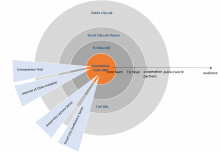Smart Communities and Technologies (SmartCT)
The Research Cluster "Smart Communities and Technologies (SmartCT)" is an interdisciplinary effort towards creating the scientific underpinnings for designing, developing, and governing complex next-generation smart city and communities infrastructures. The research results of SmartCT can be seen as a collaborative effort of involved TU Wien research groups as well as dedicated personnel and part of an overall contribution of TU Wien to the Complexity Science Hub. Smart cities and communities infrastructures are an ever-evolving and interwoven fabric of complex (1) cyber-physical systems and (2) cyber-human systems of systems covering a magnitude of different areas. By holistically approaching the challenges of creating and operating such applications, we will create methodologies, frameworks, and software systems enabling an Internet of Cities, i.e., a global complex network of Smart Cities and their applications that securely and collaboratively work to improve the quality of life of their citizens, as well as improve cost and energy efficiency of city operation and infrastructure.
| E193-07 (Research Division of Visual Analytics) |
E194-02 (Research Division of Distributed Systems) |
E193-02 (Research Division of Computer Graphics) |
| Silvia Miksch | Schahram Dustdar | Michael Wimmer |
| Alessio Arleo | Christos Tsigkanos | Chao Jia |
| Roger A. Leite | Ilir Murturi | Manfred Klaffenböck |
3 + 3 years
TU Wien
Cities are ever-evolving, complex cyber physical systems of systems covering a magnitude of different areas. The initial concept of a smart city started with cities utilizing communication technologies to deliver services to their citizens and evolved to using information technology to be smarter and more efficient about the utilization of their resources. In recent years however, information technology has changed significantly, and with it the resources and areas addressable by a smart city have broadened considerably. They now cover areas like smart buildings, smart traffic systems and roads, autonomous driving, energy hubs, electric car utilization, water/waste and pollution management, as well as concepts like urban farming. Therefore, we must enable an open adaptive interconnected approach that is able to incorporate new areas on demand overcoming potentially limiting compartmentalization. Smart cities exchanging their capabilities in an organic elastic manner, being able to address whatever challenge and opportunity they face with the expertise, data, and knowledge of a global network of expert stakeholders form the basis of our vision for an Internet of Cities.
Our central focus is to create the scientific underpinnings for a future Internet of Cities infrastructure. We will create a comprehensive set of methodologies, models, and tools for design, development, management, and evolution of next-generation smart city applications.
Initially, SmartCT captures three research areas driven by the following research challenges, which will be expanded during the duration of the project:
(1) Cyber-Physical-Human Ecosystem (Research Division of Distributed Systems)
- Enable open modeling and application environments that are able to seamlessly integrate real-world data into simulations from the physical environment at different stages during its lifecycle.
- Provide a comprehensive methodology to assist stakeholders in designing, developing, and evolving reusable and maintainable smart city applications. By doing enabling the design and development of reusable and independently maintainable application components in close cooperation with expert stakeholders.
- Provide a comprehensive middleware toolset to reliably operate and manage future smart city application, that will allow operators to seamlessly deploy and execute complex applications in an autonomic, repeatable, and observable way.
(2) Model Building and Visual Analytics (Research Division of Visual Analytics)
- Conceptualize and design VA methods for particular users exploring and analyzing particular heterogeneous, multivariate (including spatial and temporal properties) data sets and performing particular tasks.
- Capture the quality and uncertainty of the data sets in scalable and interactive VA methods.
- Tackle unpredictable, unexpected, and unforeseeable events and patterns from the past, present, and future in the VA methods.
- Utilize VA methods to guide and steer model generation and usage to achieve better predictions.
- Support communication and interaction between the human and VA methods in a user appropriate way from a task-specific perspective.
(3) 3D Spatialization (Research Division of Computer Graphics)
- Acquire 3D data in a smart city, based on different sources of input, at different times, including indoors.
- Capture the dynamic aspect of the data, i.e., detecting changes between different acquisitions.
- Spatial computation in the 3D smart city to derive new insights. This step can interact with sensor data obtained in traditional manners.
- Visualization of the 3D smart city in an efficient manner.











